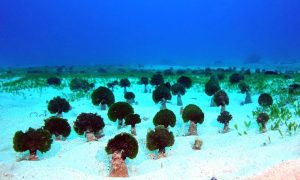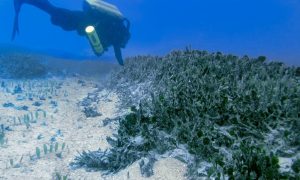Scientists ask Public to Report Sightings of Invasive Mudweed
Researchers at the University of Hawai‘i at Mānoa are asking the public to keep a watch out for a new species of leather mudweed discovered in Hawai‘i waters. The invasive algae could pose a threat to local marine ecosystems.
Scientists working under the University of Hawai‘i at Mānoa Botany department have found two populations of the mudweed living near O‘ahu shores. According to its physical and genetic characteristics, it is likely a strain of Avrainvillea erecta.
Previously, a similar species called Avrainvillea amadelpha overgrew shallow reefs in Maunalua Bay near East Honolulu and inundated seagrass meadows. However, the impacts of the newly found species are not fully known and require further study.
“There has not been very much work done on this group of green algae, and it is very challenging because it is quite variable in how it presents itself,” said doctoral student Rachael Wade, who is studying the invasive algae as part of her dissertation research. “As a result, it’s difficult to conclusively identify these species until more thorough genetic work can be completed.”
Researchers say the two species of algae are relatively easy to distinguish and identify in the water. Avrainvillea amadelpha is generally dark gray or brownish green in color and forms patchy carpets on either rock or sand. In contrast, Avrainvillea erecta generally has one green, kidney-shaped blade and a long, conical holdfast. It is only found in sandy habitats.
No one knows exactly how the algae came to Hawai‘i. Because of its proximity to urbanized estuaries and major seaports, it may have been introduced through boats frequenting the area. It’s also possible the algae was among debris that washed up in Hawaiian waters following the 2011 Tōhoku earthquake and devastating tsunami in Japan.
The public is asked to keep an eye out for either species. If spotted, the algae should be reported through Eyes of the Reef or by contacting Wade at [email protected].
“We encourage everyone to keep an eye out for this new species as they spend time in the water,” said UH Mānoa postdoctoral researcher Heather Spalding. “It’s important that we continue to track this species as it spreads.”















